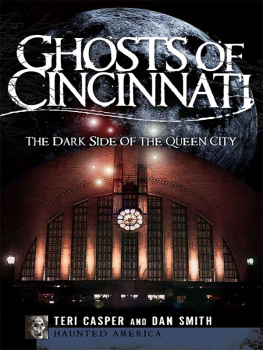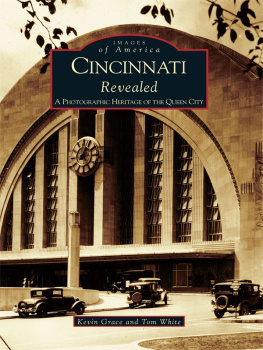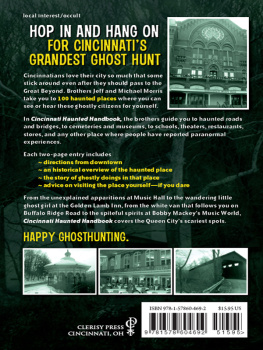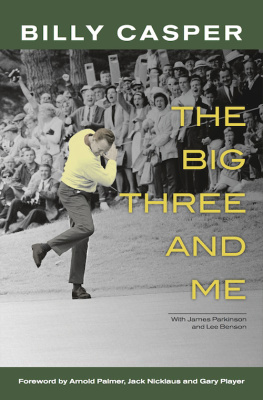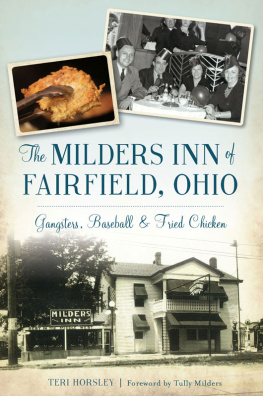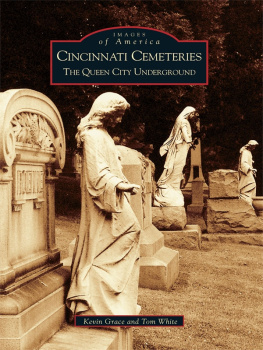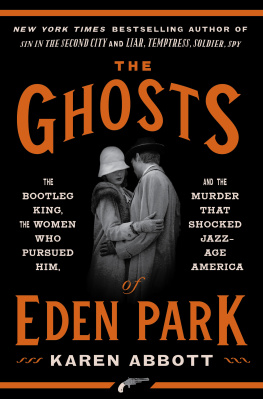

Published by Haunted America
A Division of The History Press
Charleston, SC 29403
www.historypress.net
Copyright 2009 by Teri Casper and Dan Smith
All rights reserved
First published 2009
Second printing 2011
e-book edition 2012
ISBN 978.1.61423.376.3
Library of Congress Cataloging-in-Publication Data
Casper, Teri.
Ghosts of Cincinnati : the dark side of the Queen City / Teri Casper and Dan Smith.
p. cm.
Includes bibliographical references.
print edition ISBN 978-1-59629-847-7
1. Ghosts--Ohio--Cincinnati. I. Smith, Dan. II. Title.
BF1472.U6C3745 2009
133.10977178--dc22
2009033687
Notice: The information in this book is true and complete to the best of our knowledge. It is offered without guarantee on the part of the author or The History Press. The author and The History Press disclaim all liability in connection with the use of this book.
All rights reserved. No part of this book may be reproduced or transmitted in any form whatsoever without prior written permission from the publisher except in the case of brief quotations embodied in critical articles and reviews.
CONTENTS
ACKNOWLEDGEMENTS
Many people have helped make this book possible. Before the project ever materialized, we saw a series of events brought about by several deceased family members who we think had a hand in making this book possible. Thank you to Debra Smith, our late stepmother. Your presence during this project was an amazing help. Thank you to the late Ernest Casper, whose help through life has been felt. A lot of pieces fell into place through much more than coincidence, so thank you to all who helped from beyond.
A special thanks to Kathy Casper, Michael Smith and Barbara and Jim Visota, our gracious parents who have nurtured our interest in the paranormal. Your openness and support of our ghost hunting adventures has instilled a deep respect within us for the unseen world around us. Whether skeptics or believers, many people freely gave their time and energy to help us in our quest to deliver the most complete and historically accurate account for each site.
Thank you especially to our precious girls Nevaeh and Fallon Smith, who we couldnt live without. You are very special to us, and you bring us so much joy and happiness. And finally, we couldnt ask for any better friends around us. Thank you for encouraging us every step of the way.
Thank you to the people and places who helped us dig up information about the unsavory past. With your help we were able to convey an important part of our citys history that usually goes untold.
INTRODUCTION
THE QUEEN CITY OF THE WEST
In 1788, a purchase of eight hundred acres along the Ohio River was made by Israel Ludlow, Matthias Denman and Robert Patterson. The men deemed the new town Losantiville, a convoluted contraction meaning the city opposite the mouth of the Licking River. To coax settlers into their town, they gave the first thirty who arrived four and a half acres of free land. Though the town had a slow start, settlers soon started migrating quickly.
One year later, the three founders authorized the construction of Fort Washington, which would stand to protect their citizens. Today a monument commemorates the fort near Fourth and Ludlow Streets. Three hundred soldiers moved into the fort to protect the city. The town would eventually take on the new name of Cincinnati, in honor of a Roman citizen soldier, Cincinnatus, and also named in part for the Society of Cincinnati. Cincinnati was granted status as an incorporated city in 1819.
In the early 1800s, Cincinnati built a meatpacking center. This would bring great wealth to this city. Quickly this city would become home to the highest-grossing pork-processing plant in the United States. Farmers would bring their pigs to the processing center for cash. The meatpacking plant would then slaughter the animals, process the meat, package it and ship it out. The meat shipped out fairly easily since the state had recently built the Miami-Erie Canal, which ran through Ohio and into the South. The streets were littered with many pigs who escaped from private farmers, and the city soon became known as Porkopolis. Townspeople ranted to the owner of the slaughterhouse that they did not want the pigs that were awaiting processing to get loose in the streets and add to the growing pig problem. The owner was very confident in saying that his pigs were secured in their pens and had no way of getting out. He assured them that pigs would fly before they escaped his establishment. One day thousands of the slaughterhouse pigs escaped and were running loose all over the city. The Flying Pig name stuck and is still widely used today. The city holds its annual Flying Pig Marathon, and many comical flying pig statues are displayed around town.
The 1850s brought Cincinnati its first police force. The city also became home to the first full-time, paid fire department and was the first to use steam-powered fire engines. The high-class way to travel was by steamboats. The rivers were swollen with steamboats, with as many as eight thousand docking in the city each year. Author Harriet Beecher Stowe wrote a large portion of her novel Uncle Toms Cabin while residing in Cincinnati. Her portrayal of African Americans enduring slavery caused debate during the civil rights movement. It later became the bestselling novel of the nineteenth century.
Ohio was an antislavery state in the early nineteenth century, and Cincinnati would often do its part to campaign against slavery. It would run newspaper articles to try to convince its southern neighbor of Kentucky to abolish slavery and set slaves free. The Underground Railroad helped smuggle slaves through Ohio, and Cincinnati was one of the last stops on the way to freedom. During the Civil War, the majority of Ohioans would fight for the Union. The government relied heavily on Cincinnati during this time. The city was a major supplier of new recruits and supplies for the war effort. It was also home to many soldiers and their families and was considered major headquarters for the Union.
The Roebling Suspension Bridge was built for travel by horse and buggy from Cincinnati to neighboring Kentucky and is still in use today. In 1869, the Cincinnati Red Stockings Association created the first professional baseball team in America, which would later be renamed the Cincinnati Reds after its founders. The Tyler Davidson Fountain was presented as a gift to the city in 1871 and is still the most iconic symbol of Cincinnati today. The statue sits at the center of the city on Fountain Square, with the genius of water atop the fountain.
By the turn of the twentieth century Cincinnati was the largest city in Ohio, and was the most densely populated city in the United States. The iron industry ruled Cincinnati, followed closely by meatpacking, cloth production and woodworking. The University of Cincinnati provided members of the community a proper education. Entertainment outlets included the art museum, Music Hall and Exposition Building, as well as many neighborhood saloons. Many major corporations have roots here and still maintain their headquarters here, including Kroger, Procter & Gamble, Cinergy, StarKist, Chiquita and many more.
Cincinnati faired better than most through the stock market crash and the Great Depression, mainly because of the river trade, though soon Cincinnati would have its share of hard times. In 1937, Cincinnati experienced a flood of epic proportions. The city was covered with eighty feet of water, and the only way to get around was by boat. It was estimated to have caused $20 million in damages and left one in eight people homeless.
Next page
